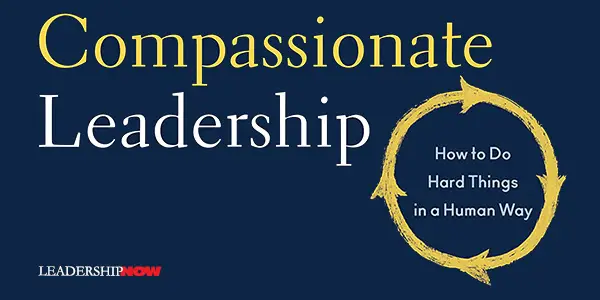 |
 |
03.11.22

Compassionate Leadership
DELIVERING bad news is never easy. As a leader it is part of the job. Many of us try to avoid it or put it off. Some few relish the reputation of being tough. But being nice or being tough is not a choice we have to make. “The hardest thing for most leaders is to find the courage to enter into difficult situations with other people,” write Rasmus Hougaard and Jacqueline Carter in Compassionate Leadership. They advocate wise compassion. They break it down this way: In this regard, wisdom in leadership is about having the courage to be candid and transparent with other people and do the things that need to be done—even when it is uncomfortable. Wisdom is to see clearly that if you don’t do the hard things today, they will become even harder tomorrow. The idea is to balance wisdom (courage) and compassion and do hard things in a human way. The secret to doing this right is of course, where you as a leader are coming from. The Wise Compassion Matrix below shows the balance needed.
In Quadrant 3, at the bottom left is the indifferent and ineffective leader. They are too busy to care and often come across as unprofessional. In Quadrant 4, leaders have the courage and candor to get hard things done, but lack heart. They put results before people. Quadrant 1 is caring avoidance. We care and wee tend to avoid the hard things. “This can be out of fear of their reaction, or it can be out of empathy, which is different than compassion.” Quadrant 2 is where we want to be—Wise Compassion. Leaders in this zone balance their concern for people with the courage and candor to get the hard things done. While we tend to fall in one quadrant over another, we can operate in any of the four depending on “our relationship with the person involved, our level of busyness, or the intensity of the pressure we are facing.” To operate out of Quadrant 2 we need four skill sets that we practice in this order: 1. Caring Presence—to be here now, with the person you are with
Sounds good but it doesn’t make hard things any easier. As a said, this has to become part of you—it’s how you approach other people. The authors devote ten chapters to ten principles to help us make this part of how we lead. 1. Unlearn Management, Relearn Being Human. You must first develop sincere relationships with those you lead. “Wise compassionate leadership is about creating truly human connections between yourself and the people you lead.” 2. Great Power Comes with Great Responsibility. We have an enormous impact on the people we lead. “Therefore, when doing hard things to others, we must ensure we do them in the most human way.” 3. Connect with Empathy, Lead with Compassion. “In leadership, empathy has it’s downsides. We can have empathetic burnout or care so much that we avoid taking necessary action.” Compassion is empathy plus action. 4. Your Oxygen Mask First. “Many senior leaders are plagued by self-criticism and self-judgment.” Silencing that inner critic is key. 5. Busyness Kills Your Heart. “Busyness kills our heart and thereby our ability to do hard things in a human way.” 6. Be Here Now. “Mindfulness enables compassion.” Know yourself and how others experience you. 7. Courage Over Comfort. “Having the courage to willingly approach confrontations is one of the most important skills of wise compassionate leaders.” 8. Direct Is Faster. “We must hold people accountable while maintaining a level of compassion.” We apply caring directness, “so people receive necessary messages quickly, enabling real conversations to begin.” 9. Clarity Is Kindness. “If we are clear and open, it helps create a culture of transparency that fosters a greater sense of psychological safety.” 10. The Only Way Out is Through. Practice is required to make this thinking a reality. “By stepping into a difficult situation and coming out on the other side with a little more wisdom and a little more compassion, we become more skillful at doing the hard things necessary to lead in a wise compassionate way.” 
Posted by Michael McKinney at 08:05 AM
|
BUILD YOUR KNOWLEDGE
 

How to Do Your Start-Up Right STRAIGHT TALK FOR START-UPS 
Grow Your Leadership Skills NEW AND UPCOMING LEADERSHIP BOOKS 
Leadership Minute BITE-SIZE CONCEPTS YOU CAN CHEW ON 
Classic Leadership Books BOOKS TO READ BEFORE YOU LEAD |